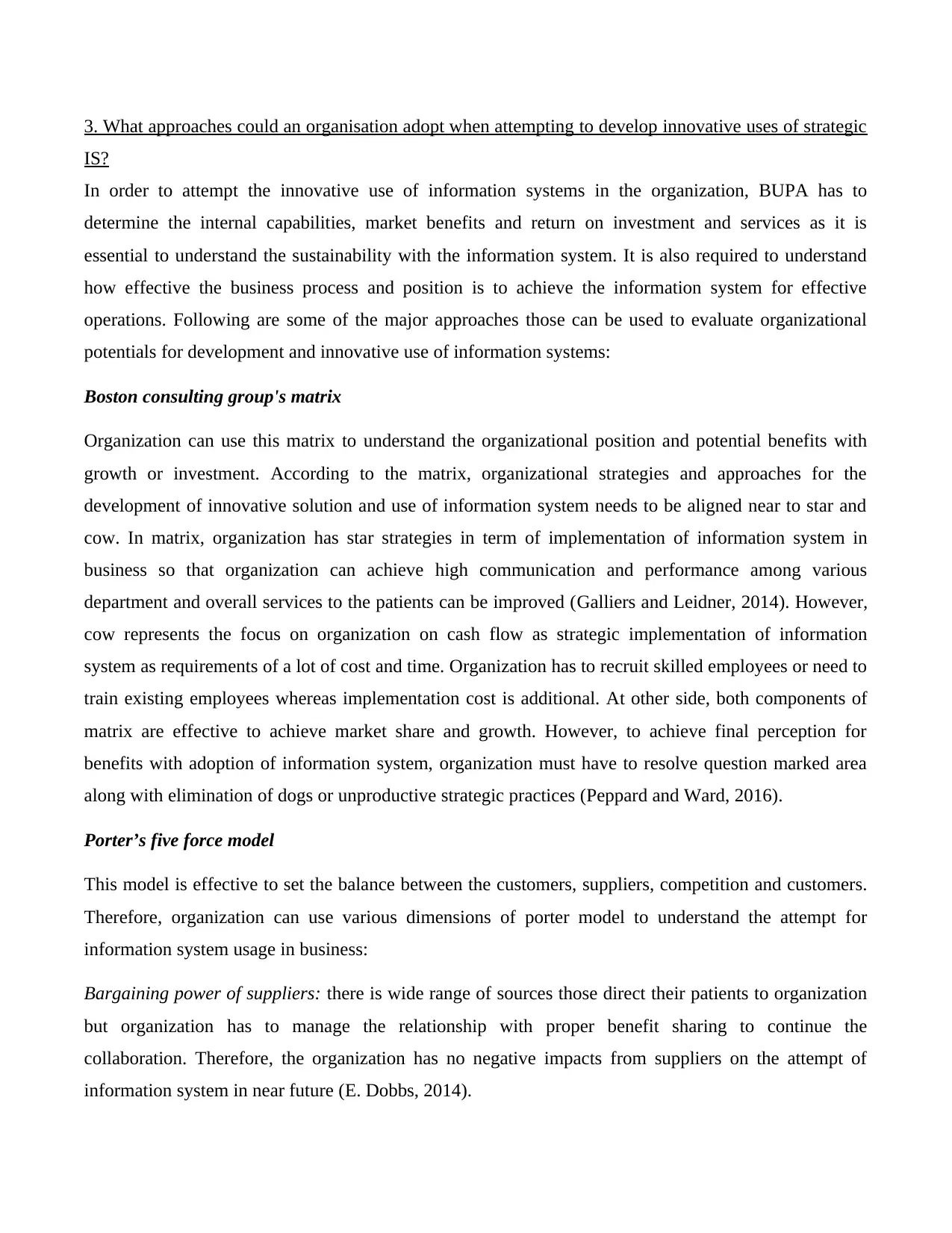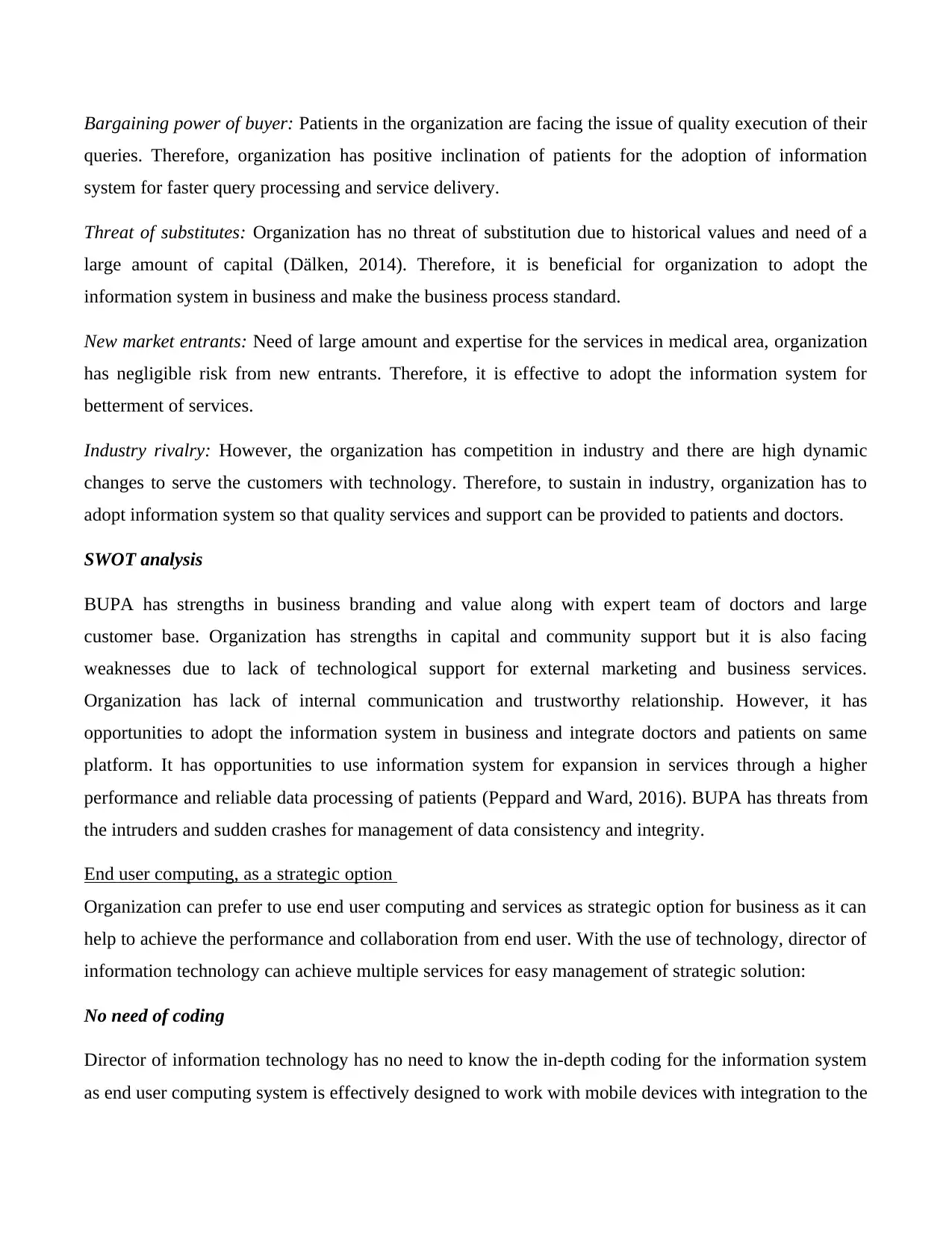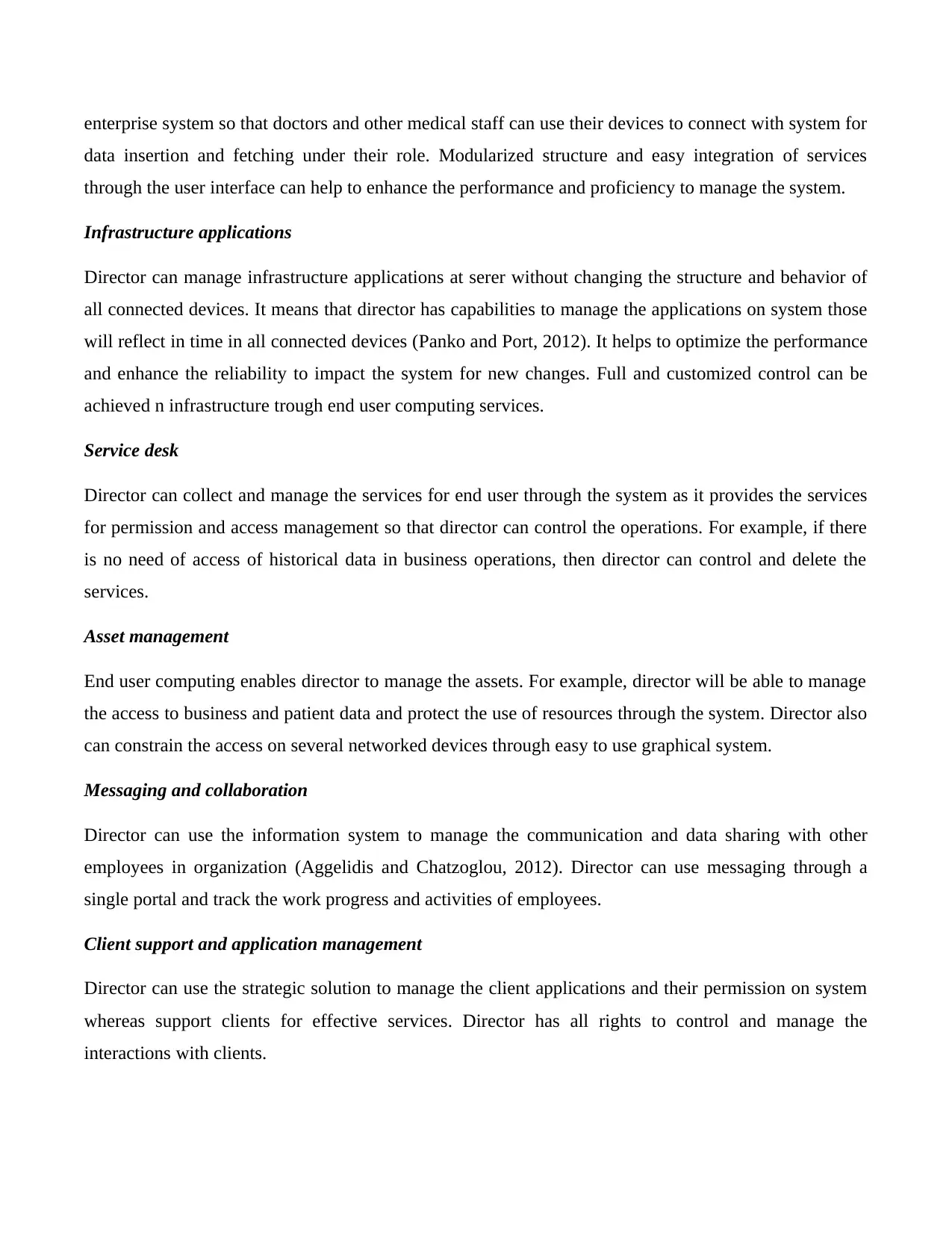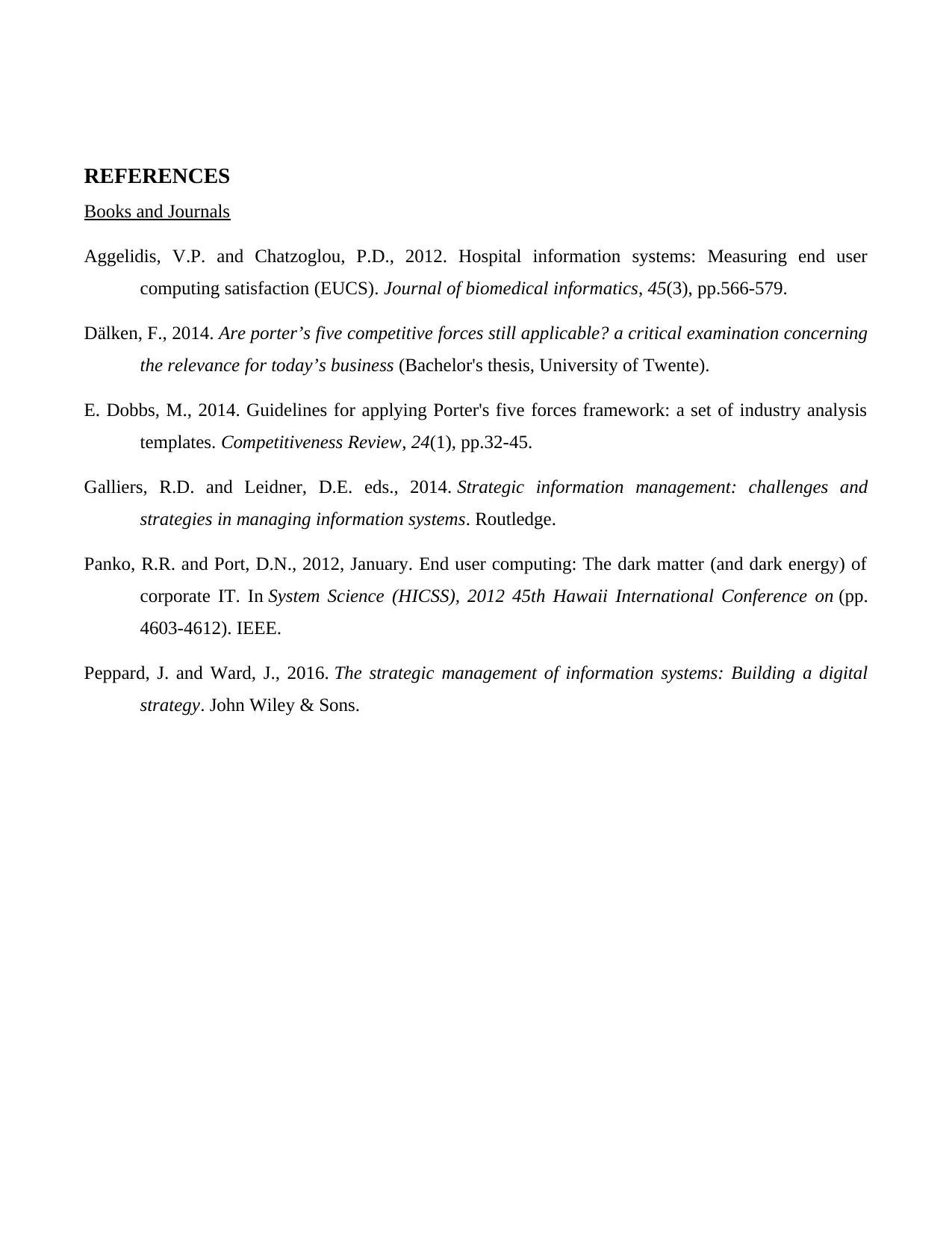Strategic Information Systems for Organizational Innovation
VerifiedAdded on 2024/04/25
|5
|1364
|197
AI Summary
To develop innovative uses of strategic IS, organizations can adopt approaches like BCG matrix, Porter's five forces, SWOT analysis, and end user computing. These methods help in evaluating potentials, market dynamics, and internal capabilities for effective implementation.
Contribute Materials
Your contribution can guide someone’s learning journey. Share your
documents today.

STRATEGIC INFORMATION
SYSTEMS
SYSTEMS
Secure Best Marks with AI Grader
Need help grading? Try our AI Grader for instant feedback on your assignments.

3. What approaches could an organisation adopt when attempting to develop innovative uses of strategic
IS?
In order to attempt the innovative use of information systems in the organization, BUPA has to
determine the internal capabilities, market benefits and return on investment and services as it is
essential to understand the sustainability with the information system. It is also required to understand
how effective the business process and position is to achieve the information system for effective
operations. Following are some of the major approaches those can be used to evaluate organizational
potentials for development and innovative use of information systems:
Boston consulting group's matrix
Organization can use this matrix to understand the organizational position and potential benefits with
growth or investment. According to the matrix, organizational strategies and approaches for the
development of innovative solution and use of information system needs to be aligned near to star and
cow. In matrix, organization has star strategies in term of implementation of information system in
business so that organization can achieve high communication and performance among various
department and overall services to the patients can be improved (Galliers and Leidner, 2014). However,
cow represents the focus on organization on cash flow as strategic implementation of information
system as requirements of a lot of cost and time. Organization has to recruit skilled employees or need to
train existing employees whereas implementation cost is additional. At other side, both components of
matrix are effective to achieve market share and growth. However, to achieve final perception for
benefits with adoption of information system, organization must have to resolve question marked area
along with elimination of dogs or unproductive strategic practices (Peppard and Ward, 2016).
Porter’s five force model
This model is effective to set the balance between the customers, suppliers, competition and customers.
Therefore, organization can use various dimensions of porter model to understand the attempt for
information system usage in business:
Bargaining power of suppliers: there is wide range of sources those direct their patients to organization
but organization has to manage the relationship with proper benefit sharing to continue the
collaboration. Therefore, the organization has no negative impacts from suppliers on the attempt of
information system in near future (E. Dobbs, 2014).
IS?
In order to attempt the innovative use of information systems in the organization, BUPA has to
determine the internal capabilities, market benefits and return on investment and services as it is
essential to understand the sustainability with the information system. It is also required to understand
how effective the business process and position is to achieve the information system for effective
operations. Following are some of the major approaches those can be used to evaluate organizational
potentials for development and innovative use of information systems:
Boston consulting group's matrix
Organization can use this matrix to understand the organizational position and potential benefits with
growth or investment. According to the matrix, organizational strategies and approaches for the
development of innovative solution and use of information system needs to be aligned near to star and
cow. In matrix, organization has star strategies in term of implementation of information system in
business so that organization can achieve high communication and performance among various
department and overall services to the patients can be improved (Galliers and Leidner, 2014). However,
cow represents the focus on organization on cash flow as strategic implementation of information
system as requirements of a lot of cost and time. Organization has to recruit skilled employees or need to
train existing employees whereas implementation cost is additional. At other side, both components of
matrix are effective to achieve market share and growth. However, to achieve final perception for
benefits with adoption of information system, organization must have to resolve question marked area
along with elimination of dogs or unproductive strategic practices (Peppard and Ward, 2016).
Porter’s five force model
This model is effective to set the balance between the customers, suppliers, competition and customers.
Therefore, organization can use various dimensions of porter model to understand the attempt for
information system usage in business:
Bargaining power of suppliers: there is wide range of sources those direct their patients to organization
but organization has to manage the relationship with proper benefit sharing to continue the
collaboration. Therefore, the organization has no negative impacts from suppliers on the attempt of
information system in near future (E. Dobbs, 2014).

Bargaining power of buyer: Patients in the organization are facing the issue of quality execution of their
queries. Therefore, organization has positive inclination of patients for the adoption of information
system for faster query processing and service delivery.
Threat of substitutes: Organization has no threat of substitution due to historical values and need of a
large amount of capital (Dälken, 2014). Therefore, it is beneficial for organization to adopt the
information system in business and make the business process standard.
New market entrants: Need of large amount and expertise for the services in medical area, organization
has negligible risk from new entrants. Therefore, it is effective to adopt the information system for
betterment of services.
Industry rivalry: However, the organization has competition in industry and there are high dynamic
changes to serve the customers with technology. Therefore, to sustain in industry, organization has to
adopt information system so that quality services and support can be provided to patients and doctors.
SWOT analysis
BUPA has strengths in business branding and value along with expert team of doctors and large
customer base. Organization has strengths in capital and community support but it is also facing
weaknesses due to lack of technological support for external marketing and business services.
Organization has lack of internal communication and trustworthy relationship. However, it has
opportunities to adopt the information system in business and integrate doctors and patients on same
platform. It has opportunities to use information system for expansion in services through a higher
performance and reliable data processing of patients (Peppard and Ward, 2016). BUPA has threats from
the intruders and sudden crashes for management of data consistency and integrity.
End user computing, as a strategic option
Organization can prefer to use end user computing and services as strategic option for business as it can
help to achieve the performance and collaboration from end user. With the use of technology, director of
information technology can achieve multiple services for easy management of strategic solution:
No need of coding
Director of information technology has no need to know the in-depth coding for the information system
as end user computing system is effectively designed to work with mobile devices with integration to the
queries. Therefore, organization has positive inclination of patients for the adoption of information
system for faster query processing and service delivery.
Threat of substitutes: Organization has no threat of substitution due to historical values and need of a
large amount of capital (Dälken, 2014). Therefore, it is beneficial for organization to adopt the
information system in business and make the business process standard.
New market entrants: Need of large amount and expertise for the services in medical area, organization
has negligible risk from new entrants. Therefore, it is effective to adopt the information system for
betterment of services.
Industry rivalry: However, the organization has competition in industry and there are high dynamic
changes to serve the customers with technology. Therefore, to sustain in industry, organization has to
adopt information system so that quality services and support can be provided to patients and doctors.
SWOT analysis
BUPA has strengths in business branding and value along with expert team of doctors and large
customer base. Organization has strengths in capital and community support but it is also facing
weaknesses due to lack of technological support for external marketing and business services.
Organization has lack of internal communication and trustworthy relationship. However, it has
opportunities to adopt the information system in business and integrate doctors and patients on same
platform. It has opportunities to use information system for expansion in services through a higher
performance and reliable data processing of patients (Peppard and Ward, 2016). BUPA has threats from
the intruders and sudden crashes for management of data consistency and integrity.
End user computing, as a strategic option
Organization can prefer to use end user computing and services as strategic option for business as it can
help to achieve the performance and collaboration from end user. With the use of technology, director of
information technology can achieve multiple services for easy management of strategic solution:
No need of coding
Director of information technology has no need to know the in-depth coding for the information system
as end user computing system is effectively designed to work with mobile devices with integration to the

enterprise system so that doctors and other medical staff can use their devices to connect with system for
data insertion and fetching under their role. Modularized structure and easy integration of services
through the user interface can help to enhance the performance and proficiency to manage the system.
Infrastructure applications
Director can manage infrastructure applications at serer without changing the structure and behavior of
all connected devices. It means that director has capabilities to manage the applications on system those
will reflect in time in all connected devices (Panko and Port, 2012). It helps to optimize the performance
and enhance the reliability to impact the system for new changes. Full and customized control can be
achieved n infrastructure trough end user computing services.
Service desk
Director can collect and manage the services for end user through the system as it provides the services
for permission and access management so that director can control the operations. For example, if there
is no need of access of historical data in business operations, then director can control and delete the
services.
Asset management
End user computing enables director to manage the assets. For example, director will be able to manage
the access to business and patient data and protect the use of resources through the system. Director also
can constrain the access on several networked devices through easy to use graphical system.
Messaging and collaboration
Director can use the information system to manage the communication and data sharing with other
employees in organization (Aggelidis and Chatzoglou, 2012). Director can use messaging through a
single portal and track the work progress and activities of employees.
Client support and application management
Director can use the strategic solution to manage the client applications and their permission on system
whereas support clients for effective services. Director has all rights to control and manage the
interactions with clients.
data insertion and fetching under their role. Modularized structure and easy integration of services
through the user interface can help to enhance the performance and proficiency to manage the system.
Infrastructure applications
Director can manage infrastructure applications at serer without changing the structure and behavior of
all connected devices. It means that director has capabilities to manage the applications on system those
will reflect in time in all connected devices (Panko and Port, 2012). It helps to optimize the performance
and enhance the reliability to impact the system for new changes. Full and customized control can be
achieved n infrastructure trough end user computing services.
Service desk
Director can collect and manage the services for end user through the system as it provides the services
for permission and access management so that director can control the operations. For example, if there
is no need of access of historical data in business operations, then director can control and delete the
services.
Asset management
End user computing enables director to manage the assets. For example, director will be able to manage
the access to business and patient data and protect the use of resources through the system. Director also
can constrain the access on several networked devices through easy to use graphical system.
Messaging and collaboration
Director can use the information system to manage the communication and data sharing with other
employees in organization (Aggelidis and Chatzoglou, 2012). Director can use messaging through a
single portal and track the work progress and activities of employees.
Client support and application management
Director can use the strategic solution to manage the client applications and their permission on system
whereas support clients for effective services. Director has all rights to control and manage the
interactions with clients.
Secure Best Marks with AI Grader
Need help grading? Try our AI Grader for instant feedback on your assignments.

REFERENCES
Books and Journals
Aggelidis, V.P. and Chatzoglou, P.D., 2012. Hospital information systems: Measuring end user
computing satisfaction (EUCS). Journal of biomedical informatics, 45(3), pp.566-579.
Dälken, F., 2014. Are porter’s five competitive forces still applicable? a critical examination concerning
the relevance for today’s business (Bachelor's thesis, University of Twente).
E. Dobbs, M., 2014. Guidelines for applying Porter's five forces framework: a set of industry analysis
templates. Competitiveness Review, 24(1), pp.32-45.
Galliers, R.D. and Leidner, D.E. eds., 2014. Strategic information management: challenges and
strategies in managing information systems. Routledge.
Panko, R.R. and Port, D.N., 2012, January. End user computing: The dark matter (and dark energy) of
corporate IT. In System Science (HICSS), 2012 45th Hawaii International Conference on (pp.
4603-4612). IEEE.
Peppard, J. and Ward, J., 2016. The strategic management of information systems: Building a digital
strategy. John Wiley & Sons.
Books and Journals
Aggelidis, V.P. and Chatzoglou, P.D., 2012. Hospital information systems: Measuring end user
computing satisfaction (EUCS). Journal of biomedical informatics, 45(3), pp.566-579.
Dälken, F., 2014. Are porter’s five competitive forces still applicable? a critical examination concerning
the relevance for today’s business (Bachelor's thesis, University of Twente).
E. Dobbs, M., 2014. Guidelines for applying Porter's five forces framework: a set of industry analysis
templates. Competitiveness Review, 24(1), pp.32-45.
Galliers, R.D. and Leidner, D.E. eds., 2014. Strategic information management: challenges and
strategies in managing information systems. Routledge.
Panko, R.R. and Port, D.N., 2012, January. End user computing: The dark matter (and dark energy) of
corporate IT. In System Science (HICSS), 2012 45th Hawaii International Conference on (pp.
4603-4612). IEEE.
Peppard, J. and Ward, J., 2016. The strategic management of information systems: Building a digital
strategy. John Wiley & Sons.
1 out of 5
Related Documents
Your All-in-One AI-Powered Toolkit for Academic Success.
+13062052269
info@desklib.com
Available 24*7 on WhatsApp / Email
![[object Object]](/_next/static/media/star-bottom.7253800d.svg)
Unlock your academic potential
© 2024 | Zucol Services PVT LTD | All rights reserved.





